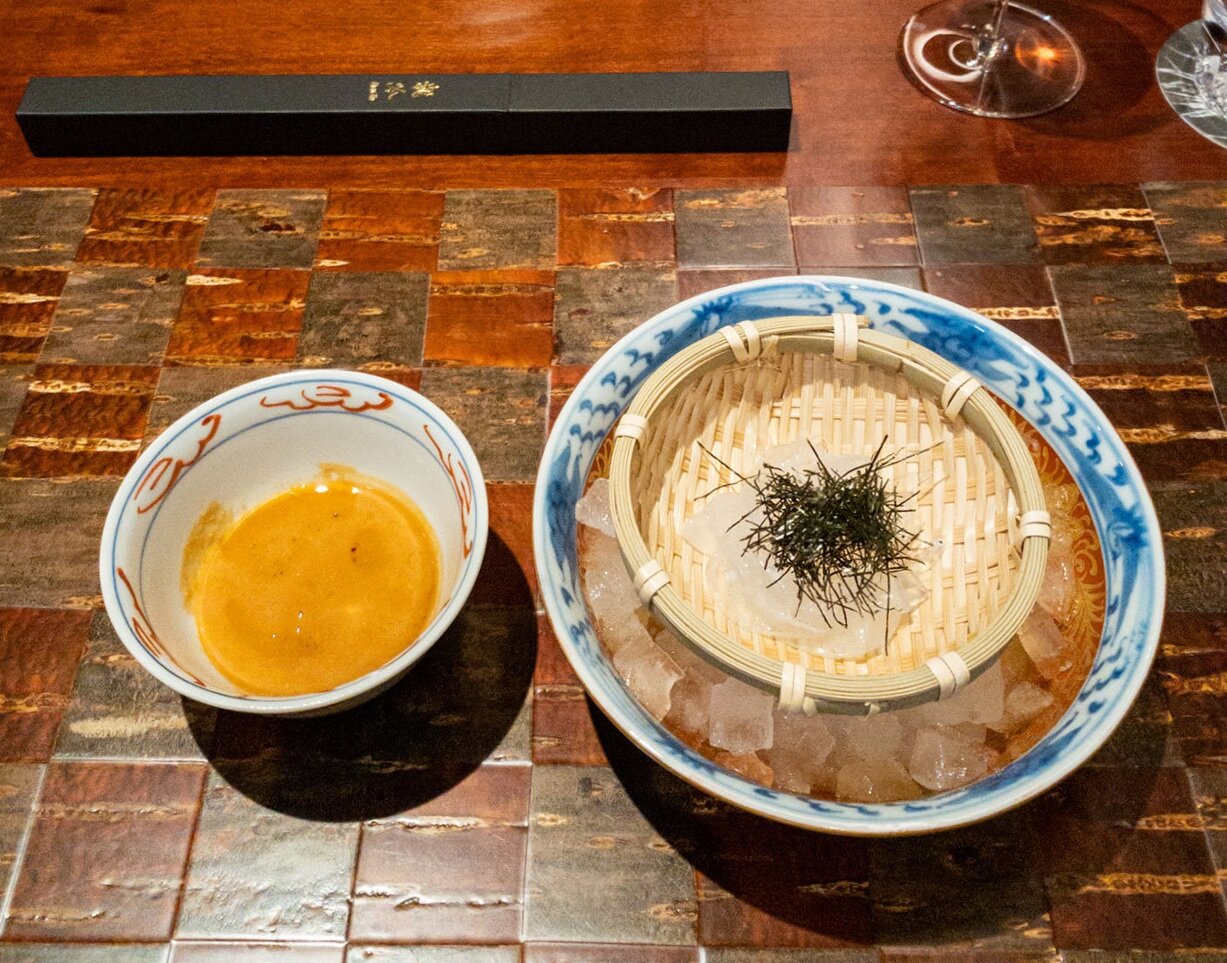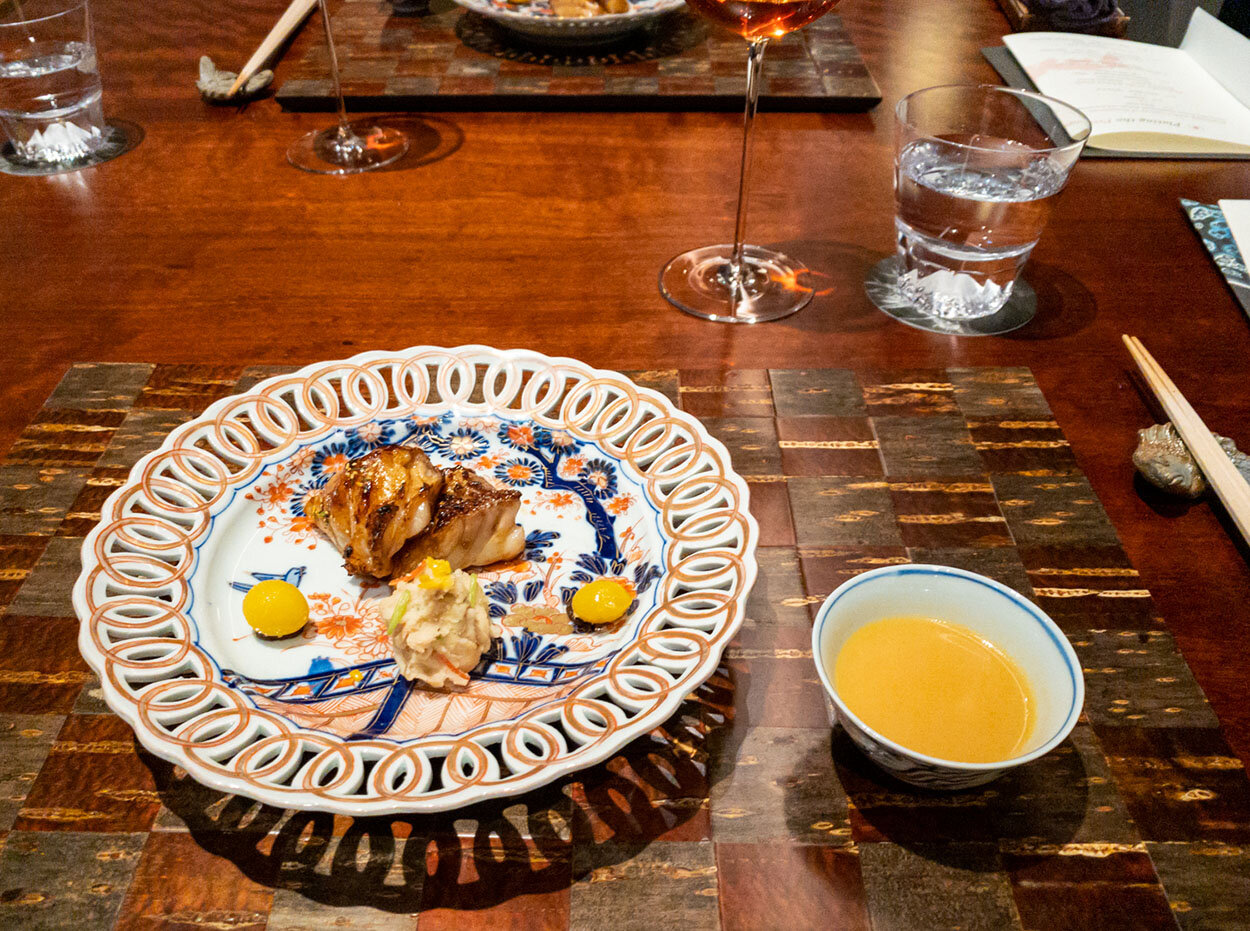Ryugin
Wrapping up our trip to Japan this season, we had dinner on our last night in Tokyo at Ryugin. One of Japan’s most famous restaurants, Ryugin has held a 3-Michelin star rating for quite some time and is consistently in the list of Asia’s 50 Best Restaurants (it was #9 this year). I know of several chefs from Hawaii that make it a point to visit Ryugin when they go to Tokyo, which has put it near the top of my wish list of places to try.
While I was excited to finally dine at Ryugin, one of the drawbacks is their photography policy. Although photography is not banned, you are limited to taking photos with your phone (my apologies for the grainy photos below) and only from certain angles. Ryugin’s reasoning here is that they are concerned that heavier cameras or taking pictures with your device directly above the food poses a danger to their antique plates and tableware. Along with this stringent photography policy, Ryugin also has a few other rules that you must agree to including not wearing perfume or cologne.
Ryugin relocated somewhat recently to occupy part of an office tower in Chiyoda city. Diners are now afforded a view of the Imperial Palace grounds, although with our late reservation things were already dark by the time we were seated.
Special teas brewed just for Ryugin
For our dinner we opted to try the tea pairings. Ryugin actually has teas made specially for them. These are then paired with various courses in order to complement or enhance their flavors. I won’t bore you with each and every pairing, but we did find them to match quite well in most cases. The tea pairing also gave us an opportunity to try some very unique teas.
“Beginning with a variety of Sensations” Part 1 - Hairy Crab
The menu at Ryugin is broken into about nine different sections, each with their own unique name or description. The first few courses, called ““Beginning with a variety of Sensations”, were all smaller dishes that highlighted some seasonal ingredients. In this first dish, a chawanmushi-style presentation of hairy crab. The very sweet, delicate, and fresh crab was a perfect match to the umami rich chawanmushi.
“Beginning with a variety of Sensations” Part 2 - Noresore
These baby conger eel were served cold with a warm dipping sauce, creating a contrast of temperatures. The eels are very thin and light in flavor.
“Beginning with a variety of Sensations” Part 3 - Spear Squid with young peas
A light charcoal flavor immediately hit the palate with this next dish. The spear squid was cooked perfectly and had an excellent tender texture. The spice of the wasabi and freshness from the peas were a nice balance to the heavy umami flavor of the soy sauce.
“Philosophy on the Ichiban Dashi” - Bamboo shoot dumpling, clam, mochi
All the wonderful flavors you’d expect, but in an interestingly colored broth. I really enjoyed the clams and the soft, chewy texture of the mochi.
“A Message from the Coast of Japan” - Seasonal sashimi
Excellent quality sea bream with a bright spot of citrus. Unfortunately, I can’t recall the second fish.
“Binchotan” - Sea perch, ginko nuts, clam okara
We had a few servings of sea perch on this trip and each one was deliciously fatty. Ryugin’s was no exception. However, the clam okara was a unique side dish that packed an extra punch of oceanic flavor.
“Once Open the Lid” - Wagyu cheek meat, shiitake mushroom
Luxurious yet somehow homey, this dish was an unusual presentation of wagyu. The fatty beef matched and earthy mushroom were naturally complimentary. The sauce was very warming and is the element that made this dish feel like comfort food.
“Grace of the Hometown” - Firewood grilled Sanuki olive beef, horseradish
I have been fortunate to try a lot of Japanese beef over the years, but never had the chance to try olive beef. This unique olive-fed cattle is highly marbled, but is said to have “healthier fat” than any other beef. If that’s the case it sure didn’t taste that way! The rich beef was similar to other Japanese wagyu I’ve had, but with a deep flavor that I could only attribute to the olive. Horseradish helps to cut the fattiness of the beef.
“The Country of Rice plants” - Sea urchin, Chrysanthemum soup, assorted pickles
The traditional ending to a kaiseki meal is usually a bowl of rice with miso soup and pickles. Ryugin really takes it up a notch. Rice is topped with premium uni (sea urchin) creating a hand roll to rival any Michelin-starred sushi restaurant I’ve been to. The soup contains tofu, which is common, but cut in a way that makes it look like a chrysanthemum flower. A beautiful and delicious end to the savory courses.
“Lusciousness Final Feast” Part 1 - Tomato, strawberry, wasanbon
This combination of tomato, strawberry, and Japanese confections was a palate cleanser that straddled the line between sweet and savory.
“Lusciousness Final Feast” Part 2 - Oryzae
The final course of the night celebrates oryzae, the fungus that helps ferment rice into sake. The hot and cold contrasts really worked well together. The souffle was so delicate and perfect.
We had a lot of kaiseki meals on this trip. In hindsight, probably too many for a single trip to Japan. That being said, our two experiences in Tokyo were far and away the best. Ishikawa was an excellent experience in more traditional kaiseki, while Ryugin was a great experience in more modern fare. Although the many list of rules at Ryugin can be a turn-off for some (and I would’ve loved to take some nicer photos with a real camera), I can say that a meal here is well worth the minor troubles.
Nihonryori Ryugin
7F Tokyo Midtown Hibiya
1-1-2 Yurakucho Chiyoda-Ku
Tokyo, Japan 100-0006
+81 03-6630-0007
www.nihonryori-ryugin.com

















